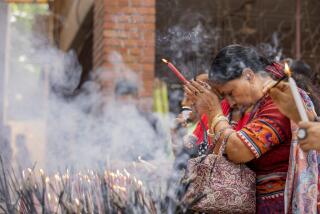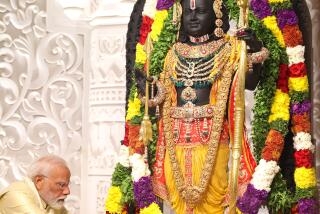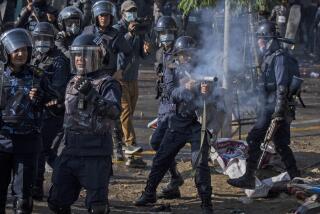New Delhi Turns From Riots to Cricket : South Asia: Sudden shift from massive protest to sports in India’s capital seen as sign the threat is over--at least for now.
- Share via
NEW DELHI — A day after about 100,000 police and paramilitary troops turned the heart of India’s capital into an armed camp and fought thousands of anti-government Hindu activists with tear gas and bamboo batons, the city turned Friday to a more important matter: cricket.
Televisions and radios in homes, sari shops, doctors’ offices and squalid street stalls were carefully tuned to the daylong cricket match in Bangalore that pitted India’s finest against England’s all-stars. India, as it happens, lost by 48 runs.
That the country could turn its attention so quickly to bowlers and batsmen was perhaps the most telling sign that the threat to the embattled government of Prime Minister P. V. Narasimha Rao by the Hindu fundamentalist Bharatiya Janata Party had passed, at least for the moment.
“The battle of Delhi is over, but the war certainly isn’t over,” said Bhabani Sen Gupta, an independent analyst at the Center for Policy Research. “This confrontation between democratic secularism and Hindu nationalism will continue for the rest of the decade.”
Sen Gupta said public confidence in the Congress Party, which has ruled India for all but three years since independence in 1947, has been sharply eroded.
The government had shown no leadership, he said, on how to fight the apparent appeal of right-wing Hindu nationalists who have stirred sectarian passions and vowed to abandon India’s constitutional guarantee of secularism.
“What is at stake is the parliamentary political process,” he warned. “A new generation of politicians has come up that has no confidence in (our British) parliamentary model and don’t even understand the model. We’re paying a terrible price for that.”
The city’s tree-lined streets and businesses returned to normal Friday as police dismantled the steel barricades, removed coils of barbed wire and trucked off oil drum roadblocks that had helped keep tens of thousands of Hindu protesters from rallying near the Parliament on Thursday.
Angry BJP members forced both houses of Parliament to adjourn early after waving a black flag and shouting that the government had unleashed “a reign of terror” Thursday. Such contretemps are common here.
But new protests called to observe what the BJP called an “anti-repression day” in the capital appeared to fizzle as well in the day’s cold drizzle.
Only about 300 people showed up early Friday for a sit-down protest outside a park devoted to the Gandhi family.
Government leaders clearly were pleased with the outcome. By their count, only 30,000 or so protesters had shown up Thursday, not the 1 million to 2 million the BJP had promised. And although police had been armed with automatic weapons, none was fired. Some 88 people were injured, but there were no deaths.
“Great restraint was used,” said government spokesman S. Narendra. “Minimum force was used.”
Narendra said most of the 60,000 people detained in the days leading up to the rally had been released. And he defended the vast security crackdown, given the nearly 2,000 people killed in Hindu-Muslim riots sparked by the destruction of a historic mosque in Ayodhya by Hindu extremists on Dec. 6. Violence affected 15 of the country’s 25 states.
“If we allowed the rally, people would say the government was weak,” he said in an interview. “If we prevented it, they say we overreacted.”
Not surprisingly, the government’s foes claim that and more. BJP party leader A. B. Vajpayee condemned the use of tear gas and baton charges as “atrocities” and vowed that Rao’s government would not be allowed to “murder democracy in the country.” But Vajpayee insisted the rally was successful since news of the crackdown had blanketed the country.
BJP leaders insist they have been energized by the government crackdown and will continue to press for Rao’s resignation and new elections, now not due until 1996.
The government, however, says the Hindu party has only frightened moderates and other potential supporters by trying to storm the capital in defiance of a legal ban.
He said that neither British Prime Minister John Major nor Russian President Boris N. Yeltsin, who both visited New Delhi in recent weeks, met with BJP leader Lal Krishna Advani, although he heads the main opposition party and normally would expect a call.
Perhaps more importantly, the World Bank last month expressed support for Rao’s ambitious program of economic reforms, the most widespread restructuring of India’s economy since independence.
More to Read
Sign up for Essential California
The most important California stories and recommendations in your inbox every morning.
You may occasionally receive promotional content from the Los Angeles Times.














